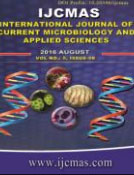


 National Academy of Agricultural Sciences (NAAS)
National Academy of Agricultural Sciences (NAAS)

|
PRINT ISSN : 2319-7692
Online ISSN : 2319-7706 Issues : 12 per year Publisher : Excellent Publishers Email : editorijcmas@gmail.com / submit@ijcmas.com Editor-in-chief: Dr.M.Prakash Index Copernicus ICV 2018: 95.39 NAAS RATING 2020: 5.38 |
Three research areas have been explored: the evaluation of the fungus P. Colocasia attacks on cocoyam (Xanthosoma sagitifolium) and taro (Colocasia esculenta), the appreciation of the influence of moisture on the development of the fungus and evaluating the effectiveness of some fungicides on the fungus P. colocasia. Four blocks each containing 30 feet of cocoyam and taro 30 feet constituted the test. These blocks were differentiated by daily watering frequency. The plants were then treated with systemic fungicides after removal of infected leaves. The results show that the humidity is a factor that favours the development of the fungus P. colocasia. Block 3 with a higher frequency of watering experienced more attacks compared to blocks 1 and 2 that were less watered and therefore a lower humidity. The frequency of watering interaction and number of attacked plants was highly significant (<5%). The disease develops in both the taro and cocoyam but with a higher rate of attacks on taro. The application of systemic fungicides on plants after extraction of infected leaves has not stopped the spread of the fungus.
 |
 |
 |
 |
 |